An Automatic Irrigation System Based on Hourly Cumulative Evapotranspiration for Reducing Agricultural Water Usage
Abstract
:1. Introduction
2. Materials and Methods
2.1. Plant Materials and Experimental Site
2.2. Calculation of the Hourly Reference Evapotranspiration
2.3. Experimental Design Using Automatic Irrigation System
2.4. Measurements of Plant Growth Parameters
2.5. Water Usage and Irrigation Water Productivity
2.6. Statistical Analysis
3. Results
3.1. Cumulative Evapotranspiration and the Number of Irrigations
3.2. Growth Parameters of Cabbage
3.3. Cabbage Head Parameters
3.4. Water Usage During the Experimental Period
3.5. Irrigation Water Productivity of Cabbage and Yields
3.6. Hierarchical Clustering Heatmap and Principal Component Analysis
4. Discussion
5. Conclusions
Author Contributions
Funding
Institutional Review Board Statement
Data Availability Statement
Acknowledgments
Conflicts of Interest
References
- Gleick, P.H. Water use. Annu. Rev. Environ. Resour. 2003, 28, 275–314. [Google Scholar] [CrossRef]
- Daigger, G.T. Evolving urban water and residuals management paradigms: Water reclamation and reuse, decentralization, and resource recovery. Water Environ. Res. 2009, 81, 809–823. [Google Scholar] [CrossRef] [PubMed]
- Demadis, K.D.; Mavredaki, E.; Stathoulopoulou, A.; Neofotistou, E.; Mantzaridis, C. Industrial water systems: Problems, challenges and solutions for the process industries. Desalination 2007, 213, 38–46. [Google Scholar] [CrossRef]
- Gössling, S.; Peeters, P.; Hall, C.M.; Ceron, J.-P.; Dubois, G.; Scott, D. Tourism and water use: Supply, demand, and security. An international review. Tour. Manag. 2012, 33, 1–15. [Google Scholar] [CrossRef]
- Issac, M.N.; Kandasubramanian, B. Effect of microplastics in water and aquatic systems. Environ. Sci. Pollut. Res. 2021, 28, 19544–19562. [Google Scholar] [CrossRef]
- Salehi, M. Global water shortage and potable water safety; Today’s concern and tomorrow’s crisis. Environ. Int. 2022, 158, 106936. [Google Scholar] [CrossRef]
- He, C.; Liu, Z.; Wu, J.; Pan, X.; Fang, Z.; Li, J.; Bryan, B.A. Future global urban water scarcity and potential solutions. Nat. Commun. 2021, 12, 4667. [Google Scholar] [CrossRef]
- Van Vliet, M.T.; Jones, E.R.; Flörke, M.; Franssen, W.H.; Hanasaki, N.; Wada, Y.; Yearsley, J.R. Global water scarcity including surface water quality and expansions of clean water technologies. Environ. Res. Lett. 2021, 16, 024020. [Google Scholar] [CrossRef]
- Biswas, A.K. Integrated water resources management: A reassessment: A water forum contribution. Water Int. 2004, 29, 248–256. [Google Scholar] [CrossRef]
- Rahaman, M.M.; Varis, O. Integrated water resources management: Evolution, prospects and future challenges. Sustain. Sci. Pract. Policy 2005, 1, 15–21. [Google Scholar] [CrossRef]
- Yang, D.; Yang, Y.; Xia, J. Hydrological cycle and water resources in a changing world: A review. Geogr. Sustain. 2021, 2, 115–122. [Google Scholar] [CrossRef]
- Jang, T.; Lee, S.-B.; Sung, C.-H.; Lee, H.-P.; Park, S.-W. Safe application of reclaimed water reuse for agriculture in Korea. Paddy Water Environ. 2010, 8, 227–233. [Google Scholar] [CrossRef]
- Korea Water Resources Corporation (K-water). Concept of Integrated Water Resources Management. Available online: https://www.kwater.or.kr/eng/futu/sub01/manaPage.do?s_mid=1197 (accessed on 18 December 2024).
- Bwambale, E.; Abagale, F.K.; Anornu, G.K. Smart irrigation monitoring and control strategies for improving water use efficiency in precision agriculture: A review. Agric. Water Manag. 2022, 260, 107324. [Google Scholar] [CrossRef]
- Touil, S.; Richa, A.; Fizir, M.; Argente García, J.E.; Skarmeta Gomez, A.F. A review on smart irrigation management strategies and their effect on water savings and crop yield. Irrig. Drain. 2022, 71, 1396–1416. [Google Scholar] [CrossRef]
- Kang, Y.; Khan, S.; Ma, X. Climate change impacts on crop yield, crop water productivity and food security–A review. Prog. Nat. Sci. 2009, 19, 1665–1674. [Google Scholar] [CrossRef]
- Misra, A.K. Climate change and challenges of water and food security. Int. J. Sustain. Built Environ. 2014, 3, 153–165. [Google Scholar] [CrossRef]
- Chowdhury, S.; Al-Zahrani, M.; Abbas, A. Implications of climate change on crop water requirements in arid region: An example of Al-Jouf, Saudi Arabia. J. King Saud Univ.-Eng. Sci. 2016, 28, 21–31. [Google Scholar] [CrossRef]
- Shinde, M.; Pawar, D.; Kale, K.; Dingre, S. Performance of cabbage at different irrigation levels under drip and microsprinkler irrigation systems. Irrig. Drain. 2021, 70, 581–592. [Google Scholar] [CrossRef]
- Bute, A.; Iosob, G.-A.; Antal-Tremurici, A.; Brezeanu, C.; Brezeanu, P.M.; Cristea, T.O.; Ambăruş, S. The most suitable irrigation methods in cabbage crops (Brassica oleracea L. var. capitata): A review. Sci. Papers. Ser. B. Hortic. 2021, 65, 399–405. [Google Scholar]
- Cisternas, I.; Velásquez, I.; Caro, A.; Rodríguez, A. Systematic literature review of implementations of precision agriculture. Comput. Electron. Agric. 2020, 176, 105626. [Google Scholar] [CrossRef]
- Basso, B.; Antle, J. Digital agriculture to design sustainable agricultural systems. Nat. Sustain. 2020, 3, 254–256. [Google Scholar] [CrossRef]
- Sharma, A.; Jain, A.; Gupta, P.; Chowdary, V. Machine learning applications for precision agriculture: A comprehensive review. IEEE Access 2020, 9, 4843–4873. [Google Scholar] [CrossRef]
- Bhat, S.A.; Huang, N.-F. Big data and ai revolution in precision agriculture: Survey and challenges. IEEE Access 2021, 9, 110209–110222. [Google Scholar] [CrossRef]
- Wanniarachchi, S.; Sarukkalige, R. A review on evapotranspiration estimation in agricultural water management: Past, present, and future. Hydrology 2022, 9, 123. [Google Scholar] [CrossRef]
- Sharma, K.; Irmak, S.; Kukal, M.S. Propagation of soil moisture sensing uncertainty into estimation of total soil water, evapotranspiration and irrigation decision-making. Agric. Water Manag. 2021, 243, 106454. [Google Scholar] [CrossRef]
- Bwambale, E.; Abagale, F.K.; Anornu, G.K. Data-driven modelling of soil moisture dynamics for smart irrigation scheduling. Smart Agric. Technol. 2023, 5, 100251. [Google Scholar] [CrossRef]
- Rushton, K.; Eilers, V.; Carter, R. Improved soil moisture balance methodology for recharge estimation. J. Hydrol. 2006, 318, 379–399. [Google Scholar] [CrossRef]
- Eisenhauer, D.E.; Martin, D.L.; Heeren, D.M.; Hoffman, G.J. Irrigation Systems Management; American Society of Agricultural and Biological Engineers (ASABE): St. Joseph, MI, USA, 2021. [Google Scholar]
- Marin, F.R.; Angelocci, L.R.; Nassif, D.S.; Costa, L.G.; Vianna, M.S.; Carvalho, K.S. Crop coefficient changes with reference evapotranspiration for highly canopy-atmosphere coupled crops. Agric. Water Manag. 2016, 163, 139–145. [Google Scholar] [CrossRef]
- Paredes, P.; Pereira, L.; Almorox, J.; Darouich, H. Reference grass evapotranspiration with reduced data sets: Parameterization of the FAO Penman-Monteith temperature approach and the Hargeaves-Samani equation using local climatic variables. Agric. Water Manag. 2020, 240, 106210. [Google Scholar] [CrossRef]
- Allen, R.G. Assessing integrity of weather data for reference evapotranspiration estimation. J. Irrig. Drain. Eng. 1996, 122, 97–106. [Google Scholar] [CrossRef]
- Zotarelli, L.; Dukes, M.D.; Romero, C.C.; Migliaccio, K.W.; Morgan, K.T. Step by step calculation of the Penman-Monteith Evapotranspiration (FAO-56 Method). Inst. Food Agric. Sci. Univ. Fla. 2010, 1–10. [Google Scholar] [CrossRef]
- Vinukollu, R.K.; Wood, E.F.; Ferguson, C.R.; Fisher, J.B. Global estimates of evapotranspiration for climate studies using multi-sensor remote sensing data: Evaluation of three process-based approaches. Remote Sens. Environ. 2011, 115, 801–823. [Google Scholar] [CrossRef]
- Allen, R.G.; Pereira, L.S.; Raes, D.; Smith, M. Crop evapotranspiration-Guidelines for computing crop water requirements-FAO Irrigation and drainage paper 56. Fao Rome 1998, 300, D05109. [Google Scholar]
- Wang, J.; Zhang, Y.; Gong, S.; Xu, D.; Juan, S.; Zhao, Y. Evapotranspiration, crop coefficient and yield for drip-irrigated winter wheat with straw mulching in North China Plain. Field Crops Res. 2018, 217, 218–228. [Google Scholar] [CrossRef]
- Pereira, L.S.; Paredes, P.; Melton, F.; Johnson, L.; Mota, M.; Wang, T. Prediction of crop coefficients from fraction of ground cover and height: Practical application to vegetable, field and fruit crops with focus on parameterization. Agric. Water Manag. 2021, 252, 106663. [Google Scholar] [CrossRef]
- Liao, R.; Zhang, S.; Zhang, X.; Wang, M.; Wu, H.; Zhangzhong, L. Development of smart irrigation systems based on real-time soil moisture data in a greenhouse: Proof of concept. Agric. Water Manag. 2021, 245, 106632. [Google Scholar] [CrossRef]
- Vidal, N.P.; Manful, C.F.; Pham, T.H.; Stewart, P.; Keough, D.; Thomas, R. The use of XLSTAT in conducting principal component analysis (PCA) when evaluating the relationships between sensory and quality attributes in grilled foods. MethodsX 2020, 7, 100835. [Google Scholar] [CrossRef]
- Jadhav, S.; Khodke, U.; Ingle, V.; Awari, H. Water use efficiency of cabbage as influenced by irrigation schedules and fertigation levels. J. Pharmacogn. Phytochem. 2020, 9, 344–348. [Google Scholar]
- Imtiyaz, M.; Mgadla, N.; Manase, S.; Chendo, K.; Mothobi, E. Yield and economic return of vegetable crops under variable irrigation. Irrig. Sci. 2000, 19, 87–93. [Google Scholar] [CrossRef]
- Farvardin, A.; González-Hernández, A.I.; Llorens, E.; García-Agustín, P.; Scalschi, L.; Vicedo, B. The apoplast: A key player in plant survival. Antioxidants 2020, 9, 604. [Google Scholar] [CrossRef]
- Suslov, M.; Daminova, A.; Egorov, J. Real-Time Dynamics of Water Transport in the Roots of Intact Maize Plants in Response to Water Stress: The Role of Aquaporins and the Contribution of Different Water Transport Pathways. Cells 2024, 13, 154. [Google Scholar] [CrossRef] [PubMed]
- Steudle, E. Water transport across roots. Plant Soil 1994, 167, 79–90. [Google Scholar] [CrossRef]
- Wu, J.; Zhang, R.; Gui, S. Modeling soil water movement with water uptake by roots. Plant Soil 1999, 215, 7–17. [Google Scholar] [CrossRef]
- Sattelmacher, B. The apoplast and its significance for plant mineral nutrition. New Phytol. 2001, 149, 167–192. [Google Scholar] [CrossRef]
- Horst, W.J.; Wang, Y.; Eticha, D. The role of the root apoplast in aluminium-induced inhibition of root elongation and in aluminium resistance of plants: A review. Ann. Bot. 2010, 106, 185–197. [Google Scholar] [CrossRef]
- Ali, O.; Cheddadi, I.; Landrein, B.; Long, Y. Revisiting the relationship between turgor pressure and plant cell growth. New Phytol. 2023, 238, 62–69. [Google Scholar] [CrossRef]
- Wilson, J.B. Shoot competition and root competition. J. Appl. Ecol. 1988, 25, 279–296. [Google Scholar] [CrossRef]
- Cahill, J.; James, F. Interactions between root and shoot competition vary among species. Oikos 2002, 99, 101–112. [Google Scholar] [CrossRef]
- Hutchings, M.J.; John, E.A. The effects of environmental heterogeneity on root growth and root/shoot partitioning. Ann. Bot. 2004, 94, 1–8. [Google Scholar] [CrossRef]
- Grzesiak, S.; Grzesiak, M.T.; Filek, W.; Hura, T.; Stabryła, J. The impact of different soil moisture and soil compaction on the growth of triticale root system. Acta Physiol. Plant. 2002, 24, 331–342. [Google Scholar] [CrossRef]
- Xu, S.; Li, K.; Li, G.; Hu, Z.; Zhang, J.; Iqbal, B.; Du, D. Canada Goldenrod Invasion Regulates the Effects of Soil Moisture on Soil Respiration. Int. J. Environ. Res. Public Health 2022, 19, 15446. [Google Scholar] [CrossRef] [PubMed]
- Xu, C.; Leskovar, D. Growth, physiology and yield responses of cabbage to deficit irrigation. Hortic. Sci. 2014, 41, 138–146. [Google Scholar] [CrossRef]
- Sarkar, S.; Saha, R.; Patra, S.K. Irrigation and fertilizer management on growth, yield, water and fertilizer use efficiencies on cabbage in a sandy loam soil. Int. J. Curr. Microbiol. Appl. Sci. 2020, 9, 64–77. [Google Scholar] [CrossRef]
- Green, S.R.; Kirkham, M.; Clothier, B.E. Root uptake and transpiration: From measurements and models to sustainable irrigation. Agric. Water Manag. 2006, 86, 165–176. [Google Scholar] [CrossRef]
- Scharwies, J.D.; Dinneny, J.R. Water transport, perception, and response in plants. J. Plant Res. 2019, 132, 311–324. [Google Scholar] [CrossRef]
- Papendick, R.; Campbell, G. Theory and measurement of water potential. Water Potential Relat. Soil Microbiol. 1981, 9, 1–22. [Google Scholar]
- Kang, Y.; Wan, S. Effect of soil water potential on radish (Raphanus sativus L.) growth and water use under drip irrigation. Sci. Hortic. 2005, 106, 275–292. [Google Scholar] [CrossRef]
- García-Tejera, O.; López-Bernal, Á.; Orgaz, F.; Testi, L.; Villalobos, F.J. The pitfalls of water potential for irrigation scheduling. Agric. Water Manag. 2021, 243, 106522. [Google Scholar] [CrossRef]

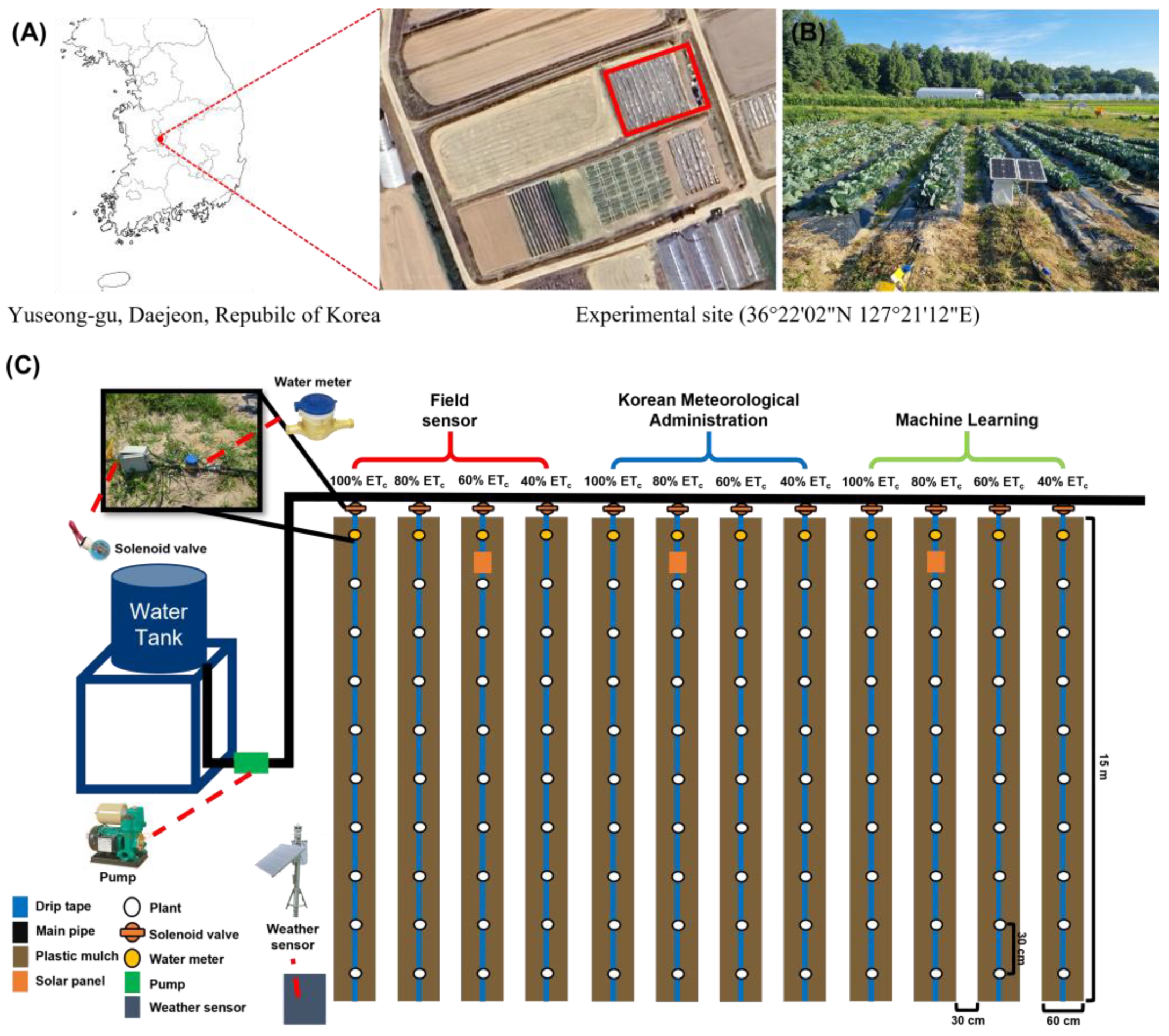
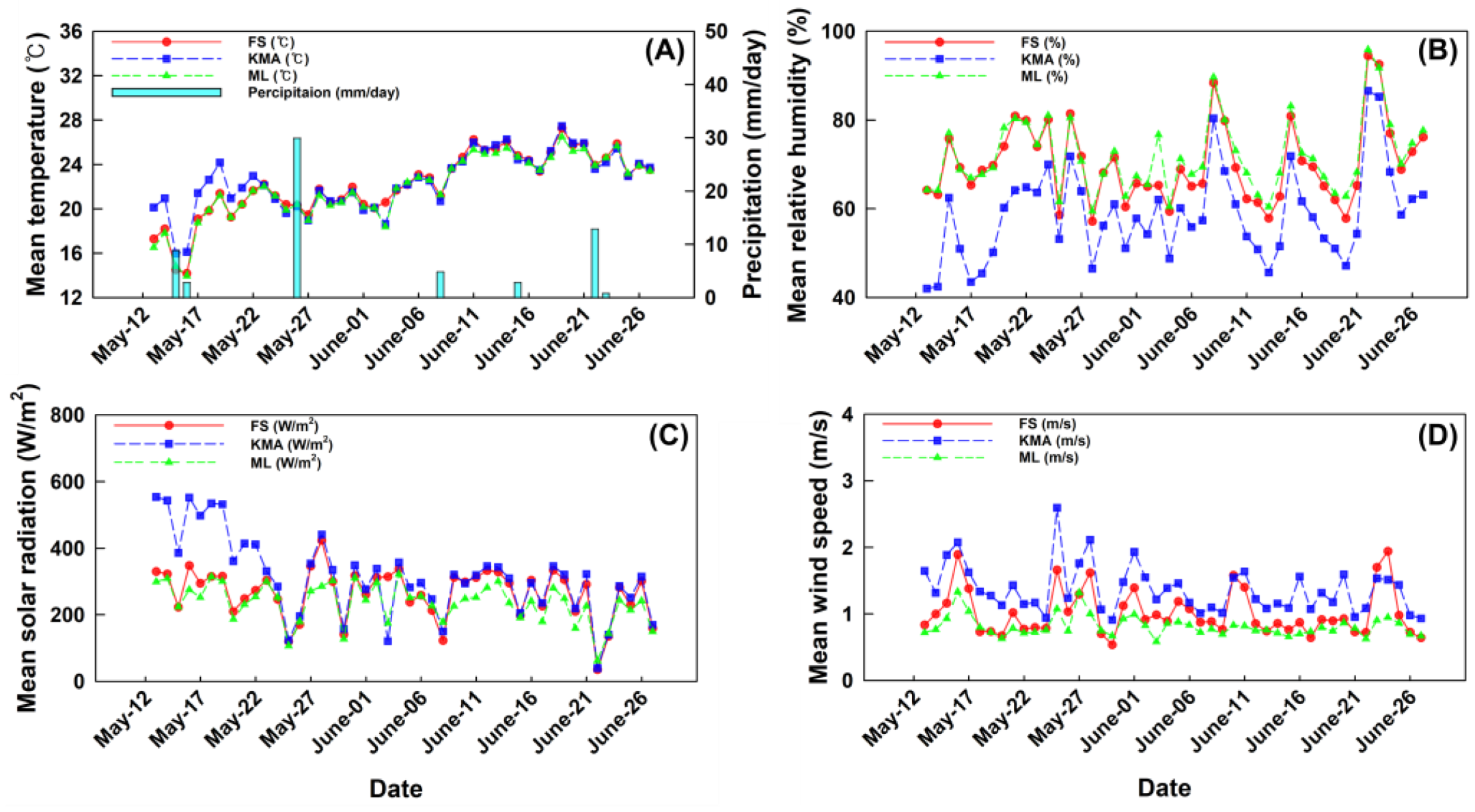

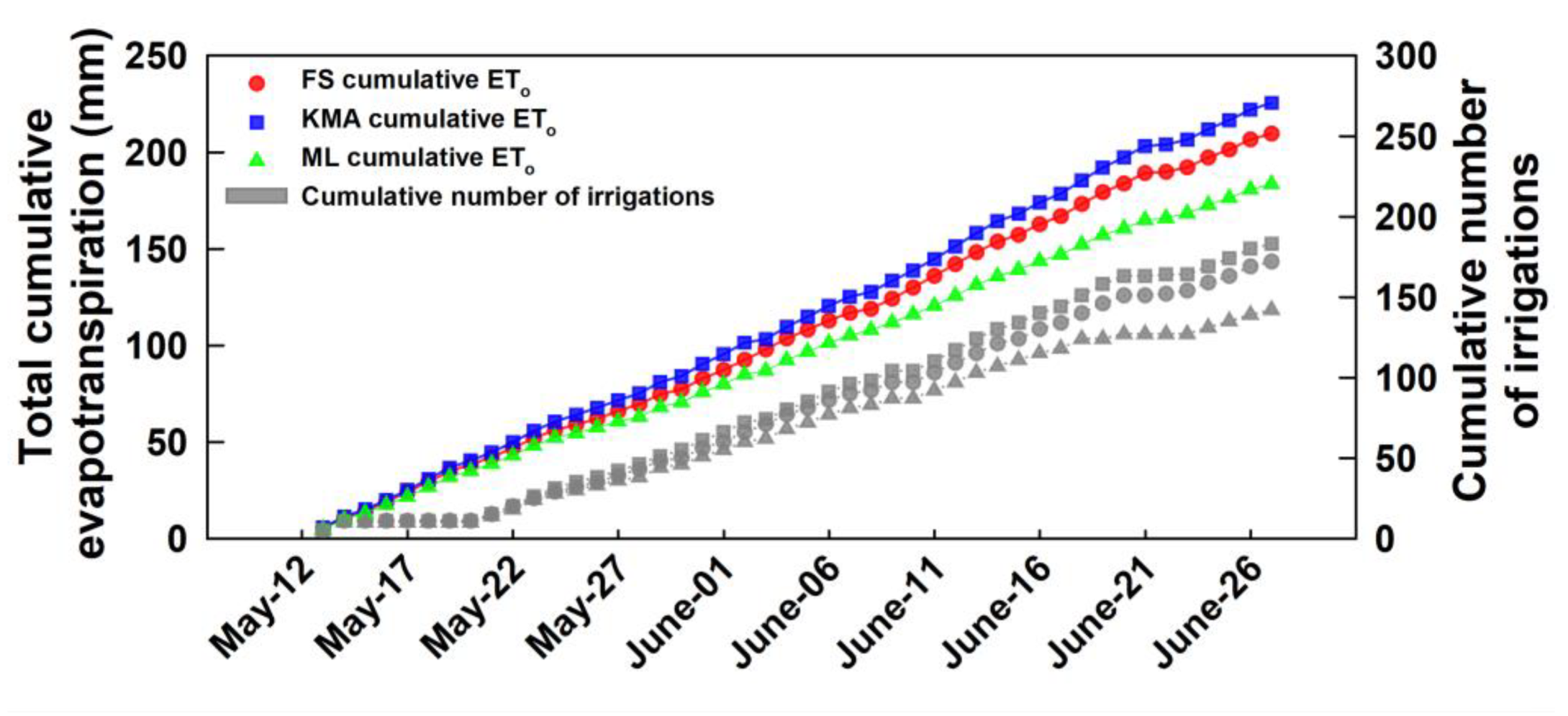

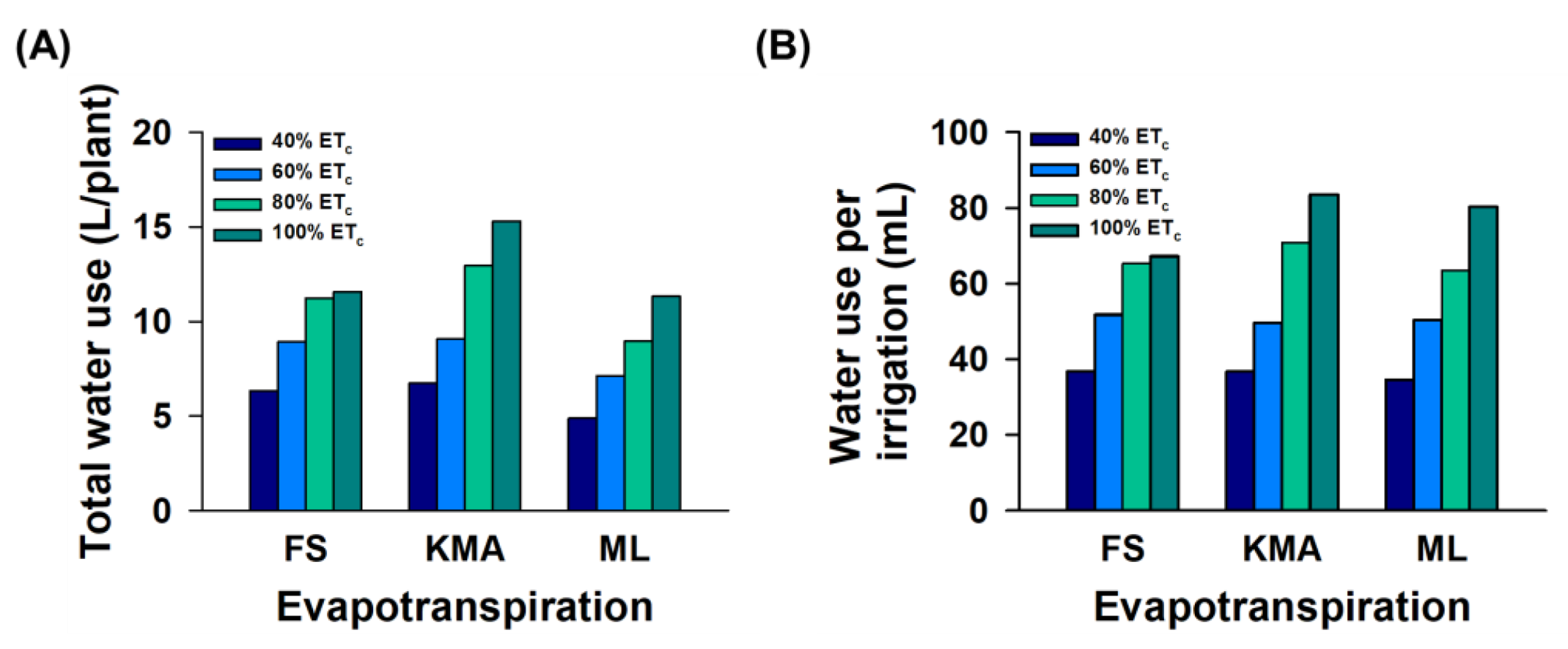
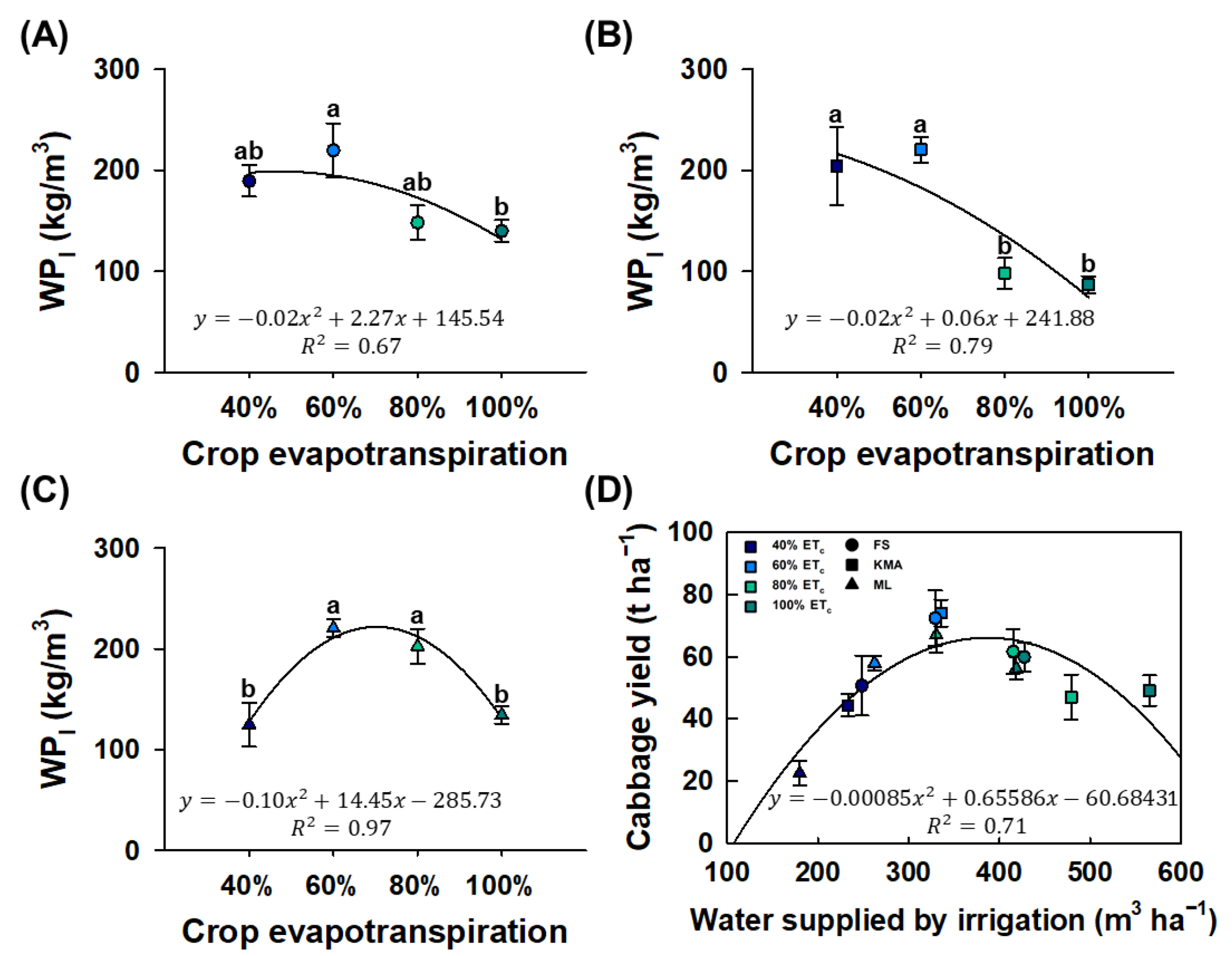

| Year | Bulk Density (g cm−3) | pH (H2O) | AP (mg kg−1) | K (cmol kg−1) | Ca (cmol kg−1) | Mg (cmol kg−1) | EC (dS m−1) |
|---|---|---|---|---|---|---|---|
| 2024 | 2.57 | 6.7 | 126 | 0.2 | 3.6 | 0.9 | 0.2 |
| Model Evaluation | Solar Radiation (W/m2) | Temperature (°C) | Relative Humidity (%) | Wind Speed (m/s) |
|---|---|---|---|---|
| R2 | 0.848 | 0.982 | 0.930 | 0.730 |
| RMSE | 101.036 | 1.340 | 5.892 | 0.384 |
| MAE | 56.453 | 0.845 | 3.924 | 0.264 |
| Irrigation Levels | Mulching Coefficient | Plant Density (cm) | Water Use per Irrigation (mL/plant) | |
|---|---|---|---|---|
| Kcmid (1.11) | Kcend (1.13) | |||
| 40% ETc | 0.8 | 0.3 | 32 | 32.4 |
| 60% ETc | 48 | 48.6 | ||
| 80% ETc | 64 | 64.8 | ||
| 100% ETc | 80 | 81 | ||
| Treatment | No. of Leaves | Leaf Area (cm2) | SPAD | Fv/Fm | SFW (g) | RFW (g) | SDW (g) | RDW (g) | |
|---|---|---|---|---|---|---|---|---|---|
| Evapotranspiration | Irrigation Levels | ||||||||
| FS | 40% ETc | 20.0 ± 0.63 | 7303 ± 690.98 b | 76.16 ± 3.80 | 0.75 ± 0.02 | 2393 ± 170.15 b | 115.14 ± 14.98 | 250.67 ± 21.24 b | 27.26 ± 2.12 ab |
| 60% ETc | 19.4 ± 0.40 | 11808 ± 963.27 a | 76.10 ± 0.53 | 0.80 ± 0.01 | 3935 ± 500.63 a | 133.06 ± 13.28 | 356.40 ± 34.55 a | 34.57 ± 2.58 a | |
| 80% ETc | 19.2 ± 0.97 | 8501 ± 516.66 b | 73.88 ± 1.50 | 0.77 ± 0.02 | 3079 ± 291.71 ab | 98.01 ± 10.70 | 246.83 ± 25.66 b | 26.32 ± 4.35 ab | |
| 100% ETc | 18.8 ± 0.49 | 8647 ± 389.59 b | 76.48 ± 2.83 | 0.80 ± 0.02 | 2937 ± 156.76 ab | 87.77 ± 5.59 | 243.67 ± 13.92 b | 20.64 ± 1.18 b | |
| Significance | NS | ** | NS | NS | * | NS | * | * | |
| KMA | 40% ETc | 20.4 ± 0.24 ab | 9273 ± 1525.18 ab | 75.14 ± 2.68 | 0.75 ± 0.02 | 2844 ± 538.44 ab | 133.68 ±29.76 | 279.21 ± 47.49 ab | 34.23 ± 7.45 a |
| 60% ETc | 19.0 ± 1.30 b | 13,368 ± 563.70 a | 78.98 ± 2.49 | 0.75 ± 0.01 | 4041 ± 24.31 a | 150.19 ± 6.04 | 345.28 ± 16.20 a | 34.31 ± 1.43 a | |
| 80% ETc | 23.8 ± 1.11 a | 9603 ± 1757.29 ab | 75.90 ± 2.45 | 0.78 ± 0.01 | 2588 ± 331.46 b | 86.98 ± 8.77 | 204.32 ± 31.89 b | 16.58 ± 2.18 b | |
| 100% ETc | 20.0 ± 0.89 ab | 7843 ± 248.45 b | 72.10 ± 2.12 | 0.80 ± 0.01 | 2535 ± 159.21 b | 92.62 ± 4.58 | 213.97 ± 11.82 b | 20.86 ± 0.86 ab | |
| Significance | * | * | NS | NS | * | * | * | * | |
| ML | 40% ETc | 25.6 ± 1.63 a | 5916 ± 252.88 b | 68.26 ± 2.12 b | 0.83 ± 0.00 | 1541 ± 136.11 b | 85.06 ± 12.19 b | 149.99 ± 8.62 b | 17.22 ± 1.73 b |
| 60% ETc | 17.8 ± 0.58 b | 9107 ± 380.63 a | 73.98 ± 1.43 ab | 0.80 ± 0.01 | 2998 ± 166.14 a | 120.40 ± 7.20 a | 298.77 ± 16.81 a | 31.99 ± 2.59 a | |
| 80% ETc | 19.4 ± 1.03 b | 8533 ± 498.90 a | 72.84 ± 1.65 ab | 0.82 ± 0.01 | 3207 ± 231.67 a | 109.53 ± 7.99 ab | 279.76 ± 18.44 a | 24.98 ± 1.63 a | |
| 100% ETc | 18.8 ± 0.8 b | 7701 ± 353.19 a | 75.48 ± 1.67 a | 0.80 ± 0.02 | 2717 ± 131.61 a | 118.92 ± 3.46 a | 277.09 ± 12.70 a | 28.53 ± 1.47 a | |
| Significance | *** | *** | NS | NS | *** | * | *** | *** | |
| Treatment | Head Diameter (cm) | HFW (g) | HDW (g) | Yield (t ha−1) | |
|---|---|---|---|---|---|
| Evapotranspiration | Irrigation Levels | ||||
| FS | 40% ETc | 15.08 ± 0.41 b | 1195 ± 97.93 b | 84.83 ± 9.34 | 44.22 ± 3.62 b |
| 60% ETc | 17.66 ± 0.60 a | 1956 ± 238.91 a | 117.58 ± 12.64 | 72.37 ± 8.84 a | |
| 80% ETc | 17.56 ± 0.68 ab | 1665 ± 191.70 ab | 97.11 ± 11.68 | 61.60 ± 7.09 ab | |
| 100% ETc | 17.54 ± 0.78 ab | 1618 ± 123.35 ab | 93.52 ± 7.34 | 59.87 ± 4.56 ab | |
| Significance | NS | * | NS | * | |
| KMA | 40% ETc | 16.08 ± 0.86 b | 1369 ± 259.87 | 96.56 ± 14.34 ab | 50.65 ± 9.62 |
| 60% ETc | 19.81 ± 0.84 a | 1999 ± 115.78 | 133.45 ± 7.02 a | 73.96 ± 4.28 | |
| 80% ETc | 16.98 ± 1.23 ab | 1270 ± 195.43 | 66.53 ± 11.61 b | 46.99 ± 7.23 | |
| 100% ETc | 16.41 ± 0.56 ab | 1325 ± 132.13 | 80.12 ± 6.83 b | 49.03 ± 4.89 | |
| Significance | * | NS | ** | NS | |
| ML | 40% ETc | 13.19 ± 0.9 b | 605 ± 238.35 b | 41.09 ± 4.84 b | 22.39 ± 3.94 b |
| 60% ETc | 18.34 ± 0.38 a | 1564 ± 142.58 a | 123.55 ± 9.30 a | 57.87 ± 2.36 a | |
| 80% ETc | 19.59 ± 0.59 a | 1809 ± 345.42 a | 125.93 ± 11.43 a | 66.93 ± 5.72 a | |
| 100% ETc | 18.93 ± 0.44 a | 1517 ± 211.85 a | 111.42 ± 9.87 a | 56.13 ± 3.51 a | |
| Significance | *** | *** | *** | *** | |
Disclaimer/Publisher’s Note: The statements, opinions and data contained in all publications are solely those of the individual author(s) and contributor(s) and not of MDPI and/or the editor(s). MDPI and/or the editor(s) disclaim responsibility for any injury to people or property resulting from any ideas, methods, instructions or products referred to in the content. |
© 2025 by the authors. Licensee MDPI, Basel, Switzerland. This article is an open access article distributed under the terms and conditions of the Creative Commons Attribution (CC BY) license (https://creativecommons.org/licenses/by/4.0/).
Share and Cite
Lee, Y.; Ha, S.-u.; Wang, X.; Hahm, S.; Lee, K.; Park, J. An Automatic Irrigation System Based on Hourly Cumulative Evapotranspiration for Reducing Agricultural Water Usage. Agriculture 2025, 15, 308. https://doi.org/10.3390/agriculture15030308
Lee Y, Ha S-u, Wang X, Hahm S, Lee K, Park J. An Automatic Irrigation System Based on Hourly Cumulative Evapotranspiration for Reducing Agricultural Water Usage. Agriculture. 2025; 15(3):308. https://doi.org/10.3390/agriculture15030308
Chicago/Turabian StyleLee, Yongjae, Seung-un Ha, Xin Wang, Seungyong Hahm, Kwangya Lee, and Jongseok Park. 2025. "An Automatic Irrigation System Based on Hourly Cumulative Evapotranspiration for Reducing Agricultural Water Usage" Agriculture 15, no. 3: 308. https://doi.org/10.3390/agriculture15030308
APA StyleLee, Y., Ha, S.-u., Wang, X., Hahm, S., Lee, K., & Park, J. (2025). An Automatic Irrigation System Based on Hourly Cumulative Evapotranspiration for Reducing Agricultural Water Usage. Agriculture, 15(3), 308. https://doi.org/10.3390/agriculture15030308






